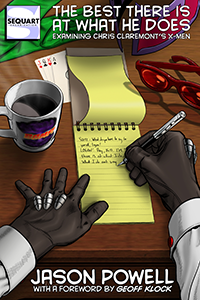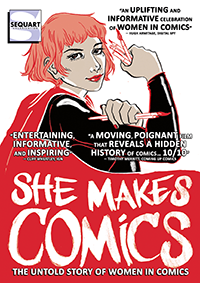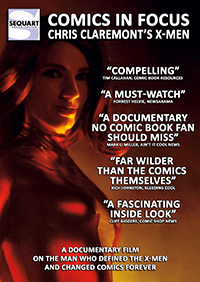Sometimes you find ideological influences in the unlikeliest places. For example, X-Men comic books helped make me a feminist. Those comics were some of the first places that I saw women as leads who did not need to derive their agency from men. They weren’t just the girlfriends. And I was reading these at a young age. Consequently when I was older and learning about feminism, I realized my views were in line with it–especially third-wave feminism, which broadened the scope of feminism by challenging what second-wave feminism believed was good and not good for women, as well as pushing back against the second wave’s narrow definition of what it means to be a feminist. So at some point in my twenties, I started to realize that concepts and theories of feminism I was reading about it and identifying with were ideas I’d always taken as matter of fact. I was actually surprised that more people–men and women–didn’t feel the same way! And because I have an obsessive need to contextualize things, I started tracing it back–when and where did I develop these opinions? Now, I could get into a number of factors and life events that played into these leanings, it certainly wasn’t solely these comics, but I’m going to stick to just those X-Men comics of my youth and young manhood for now, for a few reasons. One, it’s fun to write about them, so I’m excited to dig into it. And two, it’s probably the least likely source of inspiration for feminist leanings to most of the people that I share this with–I’ve gotten some confused expressions the few times I’ve talked about it. But from other people who’ve actually read those books or have a basic idea what’s going on in them, I get a nod of recognition, like, yeah I can see that. I like the oddness of finding the roots of one of my political ideologies in such a strange, offbeat little corner of the universe.
When I look back at the stories from the X-Men’s heyday, during a time when thousands (millions?) of kids my age were also buying the books and absorbing the lessons of this world into their systems (most of these lessons were formative, but some were best left forgotten), I see the shape of things to come. I see a large, ever-growing, ever-changing cast of characters being manipulated through a series of events, by the writer Chris Claremont, that create opportunities for heroism (it’s a superhero comic, after all), but from what were unlikely sources at the time. When you read X-Men comics, you quickly learn that the female characters don’t need saving; they’ll handle whatever comes their way just fine. And not only that, but they’ll struggle with emotional turmoil as well; they’ll be forced by circumstances into questioning the excepted way of things and why they should be expected to submit to it when they think and feel otherwise. So they fight–both literally and figuratively–to achieve the same measure of political, social, cultural, and personal rights as any male character. It might be hard to imagine this now if you’re off a certain (young) age, but this sort of representation was not common then. And looking at today’s popular culture, when it is much more prevalent than ever, it’s easy to trace back the roots of it to cultural artifacts like the X-Men comics of the 1980s and onward. If you watched and loved Whedon’s Buffy the Vampire Slayer, you might be interested to know that a lot of it was heavily inspired by those X-Men comics. More recently, you can see the stamp of the X-Men’s long-form serial storytelling on any number of modern-day entertainment from other mediums, including TV, movies, and novels. I suspect it’s partly because a lot of today’s writers grew up on those comics too.
Let’s take a look at several of the most prominent examples of X-(Wo)Men and their serving as positive feminist portrayals. Jean Grey (Phoenix), a telepath and telekinetic, is resurrected by an alien life force that slowly merges with her consciousness, allowing her mutant powers to expand exponentially over time to the point where she is easily one of the most powerful characters in comics. Storm is a women of color, born in the United States but raised in Africa. She has several powers, most prominently the psionic power to manipulate all forms of weather, anywhere at any time. She might be one of the most powerful characters in comics. Rogue can absorb anyone’s (mutant, super-being, or regular ol’ human) power set and emotions and memories, making it all her own. At times she’s also one of the most powerful characters in comics. Are you sensing a theme here yet? Almost always, the women of the X-Men were as powerful or more powerful than the men. In comics and other pop culture sites, this was not the norm at the time. And, importantly, these women are still human underneath those powers, still dealing with the emotional upheaval that comes with the responsibility.
Jean spends a few years’ worth of issues becoming gradually more powerful as the Phoenix Force overtakes her own consciousness. At first she’s unsure of what’s happening to her, but then she slowly learns to appreciate and even enjoy her new powers. We start to see her bloom into a gloriously realized version of the sort of uber-men that comic books and science fiction and fantasy stories had been throwing at us for decades. For a time, a woman was the most powerful, and dangerous, character. But later on we realize that the Phoenix Force needs to feed an insatiable hunger and Jean is losing the internal struggle to stop it. She’s losing herself, or her self. This leads to the alien life force completely eclipsing Jean’s own humanity for long stretches where she becomes the Dark Phoenix and is equipped with the seemingly unlimited powers–and appetites–of a god. To satisfy its need for more power the Dark Phoenix, fully possessing Jean now, consumes the energy of a star in a far off galaxy, resulting in a supernova that extinguishes an entire planet, consisting of millions of inhabitants, orbiting the star. It’s cosmic genocide. Ultimately, after a series of events including Jean being put on trial by a neighboring alien race for the sins of the Dark Phoenix and the X-Men battling to save her from a death sentence, she fights off the Dark Phoenix long enough to sacrifice herself, regaining her humanity, her self, in death. It’s a tragic story, made all the more tragic when seen through Jean’s eyes. Her loss of self is an exploration of identity struggle writ large against a cosmic backdrop. And through Jean’s struggle to retain her identity against extreme opposition, she proves to us her utter humanness. She is more powerful, both physically and telekinetically, than any other mutants and she doesn’t need the other X-Men to save her. She saves herself by freeing her self from the Dark Phoenix in the only way possible: death. Here is a woman who isn’t helpless in distress, like so many other portrayals from years past, but instead makes her own choices, including the most difficult choice she’ll ever have to make. You can see how this story would impact the young me, opening up a world of possibilities in my head. It was littered with symbols and images and text that were there to be examined, to serve as both signifiers and the signified, so we the readers could make meaning out of them. This sort of semiotic approach to Jean’s story allows us to see her as standing for something, standing in for anybody, for us. In many ways it doesn’t matter that she’s a woman, and then in many more ways it matters enormously that she’s a woman. This was likely the first story I read that presented a woman as focal point of her own rich and multilayered story. She was struggling against emotional and physical turmoil while losing her identity at times but always fighting to regain it, to exert her own agency over her own story. There’s a meta commentary in Jean’s story, one that makes clear that women weren’t often allowed to star in these or any stories, to have an identity outside of “the girl.” Yet here a woman takes center stage in a team book and not only thrives with unlimited power but then follows the traditionally male narrative path of the tragic, yet noble ending. It was mythic, epic, and groundbreaking stuff to a generation of young readers.
Storm is one of several characters in the book who could be the focal point of an intersectionality studies course. She likely represents the best example of intersectionality, really, out of all of the characters, with her overlapping and intersecting social identities of black woman, African goddess, mother figure, and long-time team leader, to name a few, and her constantly being challenged by forces of oppression, discrimination, and domination. In one of the best and most famous stories of the era, Storm loses her powers for a stretch and goes on a soul searching journey in order to reevaluate what she means anymore without them–both to others and herself. She winds up finding a rebirth of sorts, one that leads to an inner calm and a greater self-awareness. She also changes her look, from goddess/superheroin chic to glam/punk rock icon, even cutting her long flowing white hair into a Mohawk. That Mohawk Storm still has such a rabid, and rabidly feminist, fan base all these years later, and that Marvel brought back the haircut in recent years just shows how strong of an impact the character had and still has on readers. She’s easily one of the most powerful characters along with being one of the most intelligent, resourceful, and level headed. She is an early signifier of third-wave feminism, a black woman in America of African heritage and upbringing whose sexuality cannot be easily categorized (I think she’s straight but has had a great and enduring love for several women), and who represents a challenge to previously accepted notions of what a feminist is and is not. And in Storm, the X-Men finally had a character who makes explicit all of the mutants-as-minority themes that the book had been pursuing since its inception in the 1960s. With Storm, we have a character who isn’t nominally Other while still white, but instead one who is Other, a nonconformist minority character who doesn’t abide by the stated political and social power structures but instead acts as a role model for how the disenfranchised can push back against these oppressive norms. And when Storm sports the Mohawk and leather jacket, she creates an iconic representation for readers on the margins, both female and male. For these reasons, she’s easily one of the most perfectly realized X-Men characters, and there are some wonderfully realized characters in that world, so that’s saying something.
When Rogue first discovered her mutant abilities, she was just a young girl being kissed by a young boy she was attracted to. Rogue inadvertently absorbed the boy’s life force and psyche, leaving him in a coma. From then on, the kind of casual skin-to-skin contact that we all take for granted is an impossibility for Rogue, unless she’s deliberately trying to use her powers (which I should note, after her initial appearances, she uses them almost exclusively for benevolent reasons, usually to help others). Coincidentally I suppose, AIDS was first recognized by the US CDC in the same year that Rogue debuted. But that era’s fear of not only sex but also just human contact had to inform the character’s development during that time. And beyond that, Rogue’s powers can be seen as a curse, her body and mind betraying her and the people she touches. And we all know how fraught the conversations around women’s bodies, and minds, can be. Women’s bodies and their choices regarding them are simultaneously admired, objectified, and legislated by men. I think Rogue can be seen as a metaphor for all of that. You see her evolve from being a darker character working against the X-Men to fairly quickly being accepted into their family, only reluctantly by several of them at first. She matures emotionally and learns to control her powers better. And while the risk of placing those she touches in a coma are slim now that she has greater control, the psychic toll it can take on her is still huge. After absorbing someone’s psyche and abilities, her mind is still flooded with that person’s thoughts and emotions. Until her absorption of their psyche wears off, she’s living with this person’s mind inside of her own mind, basically. It’s overwhelming at times. This aspect of the character leads to some excellent explorations of Rogue fighting to hang on to her own identity while processing the identity of someone else. Like Jean earlier, we see more identity struggles, more metaphors for how hard it can be for women to have an identity that isn’t seen only in relation to others. But Rogue, against all odds, becomes a fiercely independent woman whose distinct and multifaceted personality–which is playful, willful, sarcastic, loving, and much more–sets her apart from the other characters. After her rough start in the series, she truly stands out as an individual and learns to exert control over her mutant abilities with aplomb. She’s a phenomenally rich character.
An important character that I didn’t mention above but would be remiss in leaving out is Kitty Pryde. There’s a reason why she’s name checked—along with one of the most well-rounded and thoughtful male X-Men, Nightcrawler—in Weezer’s song “In the Garage”: nerds love Kitty. They love most of the X-Men, but Kitty is definitely a fan favorite with nerds. Probably because she’s a nerd herself—off-the-charts intelligence, computer wiz, and a mutant ability that allows her to phase through almost anything, to literally disappear and avoid harm (what nerd wouldn’t want that power?). For my generation, Kitty served as audience surrogate, so that also hooked readers on her as a character. She was only a young teenager when she joined the X-Men, a fish out of water among her older teammates. As she matured, readers could see themselves in her awkward attempts at growing up. And unlike the other women I’ve mentioned so far, Kitty is rarely among the most powerful mutants. But like these other women she’s definitely one of the most important. She serves as the heart of the team in most iterations of it. She’s a kind, compassionate, but also firm and assertive woman. Like real women, she can be more than one thing.
Jean, Storm, Rogue, and Kitty represent more nuanced and complex characters, the kind that were rarely allowed to be women previously in comics or other forms of storytelling. It’s no surprise that a segment of readers who grew up on these stories learned both that comic books could contain real depth of meaning and also that female characters could be portrayed as agents of change, as the focal points of entire stories and books. And in some cases like mine, these characters and their epic stories helped shape our opinions on how the world should work.























































